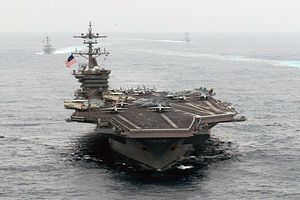The USS Carl Vinson Strike Group arrived in the South China Sea this week, the first major U.S. presence in the region under the Trump Administration. The Strike Group’s arrival closely follows reports that the U.S. Navy is seeking to engage in the western Pacific more assertively with increased presence and more frequent Freedom of Navigation Operations (FONOPS) against Chinese maritime claims around its artificial-island bases in the Spratly and Paracel islands.
Asked about speculation that the Strike Group might conduct some of these proposed FONOPS, a Chinese Foreign Ministry Spokesperson urged the United States “to refrain from challenging China’s sovereignty and security.” While the Carl Vinson Strike Group provides a credible combat presence in the highly contested region, its current makeup suggests it is unlikely to conduct any FONOPs for the time being.
Since 2015, destroyers that were either operating independently or were broken off from larger groups of ships conducted all four acknowledged South China Sea FONOPs against excessive Chinese maritime claims. The USS Lassen was operating independently when it transited near Subi Reef in October 2015. In January 2016, the USS Curtis Wilbur was also operating independently when it made its FONOP assertion against excessive Chinese maritime claims around Triton Island in the Paracels. The USS William P. Lawrence conducted a FONOP near Fiery Cross Reef in the Spratly Islands that May while it was attached to the John C. Stennis Strike Group, which included at least two other ships attached to the aircraft carrier. The most recent FONOP was conducted by the USS Decatur last November, again against Chinese maritime claims around the Paracel Islands, while the ship was attached to an independent Surface Action Group that was not assigned to an aircraft carrier.
Like the John C. Stennis, the Carl Vinson also deployed with three escorting ships, one cruiser and two destroyers. However, when the carrier was reported to have entered the South China Sea on February 18 it was with only one escort ship, the destroyer USS Wayne E. Meyer. The carrier’s two other escorts are currently engaged in other tasking. The destroyer USS Michael Murphy is in Oceania participating in a maritime security initiative helping Pacific Island nations combat illegal fishing and other criminal activity, while the cruiser USS Lake Champlain was in Saipan in the Marianas Islands last week. Until either ship rejoins the Carl Vinson, it is unlikely that the aircraft carrier’s sole escort ship would be broken off to conduct a FONOP or any other independent mission.
In addition to the Carl Vinson, the Littoral Combat Ship (LCS) USS Coronado also began a new South China Sea patrol at the beginning of February, but is also unlikely to be used for a FONOP. Since 2012, the U.S. has maintained a forward-deployed Destroyer Squadron in Singapore to direct the operations of rotationally deployed LCSs. Under the arrangement an LCS deploys to Singapore for a year or more, during which several crews will switch-out; Coronado arrived in October of last year. While this permits the U.S. Navy to maintain a near continuous presence in the South China Sea, it’s questionable whether the lightly-armed LCS provides credible presence in a region filled with Chinese destroyers and frigates. No LCS is known to have conducted a FONOP against Chinese claims in the region.
The Coronado’s predecessor in Singapore, the USS Fort Worth, was closely trailed by a much more heavily armed Chinese frigate during one of its early South China Sea patrols in May 2015. When Fort Worth conducted its next patrol in the region it was accompanied by a destroyer, the USS Lassen. It isn’t known whether the joint patrol with the much more heavily armed ship was a reaction to Fort Worth’s earlier encounters with the Chinese warship, but the LCS-class has been heavily criticized for lacking a potent anti-ship weapon to defend itself with. The Coronado is notable for being the first LCS to be armed with Harpoon anti-ship cruise missiles as part of a proof-of-concept. Earlier this year the Navy revealed it will soon seek proposals for a long-range, over-the-horizon anti-ship missile to arm new ‘up-gunned’ LCS variants and to back-fit existing hulls

































